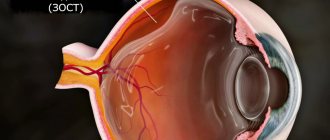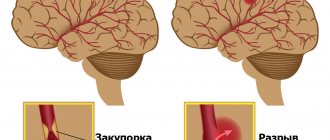The appearance of blurred vision and dizziness are two symptoms that often occur simultaneously or one after another. Most people explain this by fatigue and lack of sleep. However, these signs may indicate some kind of disease. In what cases should you definitely see a doctor and not ignore these symptoms?
There are many reasons why a person becomes dizzy and gets dark vision. Conventionally, all factors that provoke these symptoms can be divided into two groups:
- unrelated to diseases;
- pathological.
Symptom Description
With a unilateral decrease in visual acuity, which is observed against the background of intraocular hypertension, inflammatory eye disease, hemorrhage in this area, the optic nerve may also be affected. A bilateral process is often associated not with local changes in the eyes, but with a systemic disease (cardiovascular pathology, renal failure, severe blood loss, diabetes mellitus).
Blurred vision may be constant or appear towards the end of the day. Decreased vision can occur both in the central parts and in the periphery.
All this must be taken into account when describing complaints - this will help to quickly understand the diagnosis.
Prevention
Simple rules of prevention will help prevent the development of serious diseases. Basic recommendations:
- Consult a doctor promptly, especially if dangerous symptoms develop.
- Select the right optical models for vision correction. To do this, you need to consult a doctor.
- If you have chronic diseases, such as diabetes, you should regularly visit an ophthalmologist.
- Long-term eye strain requires the use of moisturizing eye drops, especially when working at a computer. This will help prevent the development of dry eye syndrome.
- Do not self-medicate to avoid side effects.
The causes of unpleasant symptoms such as dizziness and blurred vision can be varied. You should not self-medicate, as there may be a risk of developing unpleasant symptoms.
Why does fog appear before my eyes?
Common reasons
The appearance of fog in the eyes can be associated with severe toxicosis in pregnant women, poisoning with alcohol products (ethyl and methyl alcohol), overdose of quinine, nicotine, lead and other active substances.
Quite rarely, blurred vision is a consequence of vasospasm of the retinal vessels. In this case, a functional disturbance of blood flow through these arteries occurs, which does not lead to organic changes in the vessels. Typically, patients with hypertension and frequent migraine pain are susceptible to vasospasm. In addition, arterial spasm occurs in pregnant women with eclampsia or preeclampsia, as well as against the background of chronic stress and severe poisoning. Fog in the eyes in this case can be combined with the appearance of floating black dots or flickering spots, and visual acuity is also temporarily (up to several hours) reduced.
If the doctor suspects angiospasm in the patient, then an ophthalmoscopy should be performed, which will show in which area of the fundus the local narrowing of the arteries has occurred. Usually the fundus itself is not changed during ophthalmoscopy, except in situations where the cause of vasospasm is atherosclerotic damage to the vascular stack (in this case, a picture of sclerosis of the retinal arteries is revealed).
Blurred vision can be a sign of a stroke, high or low blood pressure, high or low blood sugar [2].
Eye diseases
A disturbance in one of the light-conducting structures of the eye—the cornea, lens, or vitreous body—leads to decreased vision [3]. The veil can also be caused by a lesion in the light-receiving part (retina) or due to diseases of the optic nerve (neuritis).
Fig. 2 Light-conducting media of the eye, light-receiving apparatus and optic nerve
Glaucoma is considered one of the most common causes of foggy eyes in older people. As a result of an increase in the level of intraocular pressure in primary, post-traumatic, and secondary glaucoma, a veil appears before the eyes and overall visual acuity decreases. Other symptoms characteristic of glaucoma are pain in the eyes themselves, in the head (temporal, superciliary areas), the appearance of rainbow circles or glare around point light sources, as well as fog in the eyes [4].
During an ophthalmological examination, which is carried out in patients with such complaints, corneal edema and a decrease in the depth of the anterior chamber of the eye can be detected. With advanced changes, pallor of the optic nerve head and its excavation also occur.
Another common cause of foggy eyes in older people is DVT - destruction of the vitreous body - age-related clouding of the biological lens of the eye (lens). The process develops gradually over several years. Cataracts can appear in young people due to trauma, radiation (“radiation cataract”), or diabetes [5].
Violation of the structure and transparency of the vitreous body (the gel-like substance that fills the eye from the inside) leads to the appearance of fog, floating “cobwebs” and “worms before the eyes.” This condition is called DVT - destruction of the vitreous body, which is often accompanied by posterior vitreous detachment (PVD).
Fig. 4 Changes in the vitreous body, leading to decreased vision
Fog in the central field of vision can be caused by age-related macular degeneration (AMD) - both dry and wet forms, macular edema due to a number of reasons (diabetes, central serous chorioretinopathy, etc.).
Retinal detachment, when the inner retina detaches from the wall of the eyeball and quickly dies, poses a great danger. Without emergency surgery, vision is lost forever [6].
Inflammatory eye diseases - conjunctivitis, retinitis, uveitis can also lead to blurred vision. At the same time, signs of inflammation are not always expressed clearly enough. Quite often, there is only a gradual decrease in visual acuity and the appearance of floating spots before the eyes, which gradually increase in size. Acute signs of inflammation, including pain, photophobia, redness, are more typical for the acute course of iridocyclitis or iritis. The main sign of anterior uveitis, rather, can be called narrowing of the pupillary opening or hyperemia in the area located near the limbus.
Foggy eyes after surgery
Blurred vision after surgical interventions - laser vision correction, cataract removal, etc. for several days (up to a week) is a completely normal phenomenon and is associated both with the presence of inflammatory edema of the cornea in response to surgery, and can also be caused by the antibacterial and anti-inflammatory drops used.
Fig. 5 Eye on the first day after cataract removal - corneal edema and hyperemia (redness) of the conjunctiva
Fatigue
Prolonged rides on a carousel or driving a car can also cause blurry vision, nausea, headaches, and weakness. The fact is that the human brain is overloaded with incoming information, and discomfort is expressed precisely in dizziness, which can be associated with excessive fatigue, frequent lack of sleep, and overwork.
Stressful situations result in a lack of oxygen, which leads to the appearance of floating images in the eyes. This is accompanied by nausea and dizziness.
Diagnostics
To diagnose the primary disease that has led to the appearance of fog before the eyes, you need to perform, at a minimum, biomicroscopy using a slit lamp and examine the fundus with a wide pupil. In this case, it is often possible to identify signs of damage to the cornea, lens, vitreous body or retina [7].
Testing vision with and without correction, as well as determining refraction in conditions of a dilated pupil (cycloplegia) will help identify disorders such as spasm of accommodation, myopia, farsightedness and astigmatism.
Determination of intraocular pressure (IOP) excludes or confirms glaucoma.
Fig. 6 Basic examination (biomicroscopy and ophthalmoscopy) allows in most cases to identify the cause of the appearance of fog
In some cases, additional examinations are necessary to clarify the diagnosis—primarily optical coherence tomography of the retina (including with angiography function) [8]. This method allows you to see minimal changes in the central zone of the retina and the optic nerve head (ONH), accurately and quickly make a diagnosis and prescribe treatment. This test is available in our clinic on the same day of your visit.
| Study | Signs | Disease |
| Vision testing with and without correction | Descending into the distance | Myopia, farsightedness, astigmatism, accommodation spasm |
| Measuring intraocular pressure | Promotion | Acute attack of glaucoma |
| Biomicroscopy of the cornea | Swelling, cloudiness | Keratitis |
| Biomicroscopy of the lens | Cloudiness | Cataract |
| Vitreous ophthalmoscopy | Cloudiness, peeling | DST, ZOST |
| Retinal ophthalmoscopy | Swelling, ruptures, detachment | Macular degeneration, retinal detachment and tears |
| Ophthalmoscopy of the optic disc | Swelling, pallor | Optic neuritis, glaucoma, atrophy |
Table 1. Research method, signs and final diagnosis
Therapy of vascular pathologies
If your vision is swimming, and the reason for this is dizziness associated with disruption of the blood vessels in the brain, specific treatment is prescribed, based on the use of vasodilators.
When the vertebral arteries are narrowed, physiotherapy, in particular massage, is used. If this phenomenon is caused by any intoxication, its manifestation should be eliminated through symptomatic therapy.
Treatment
Blurred vision can only be cured by identifying the cause of this condition. Often, a patient with such a symptom requires emergency hospitalization and immediate surgical intervention (for example, during an acute attack of glaucoma). Due to the high probability of serious complications, at the first appearance of fog in the eyes, you should consult an ophthalmologist.
When choosing a center where you want to receive medical care, you need to pay attention to the ophthalmology clinic that has fairly modern equipment, experienced specialists, and does not require long waiting in line. It is important not to put off taking care of your vision too long!
Pathological causes
A large number of factors influence vision deterioration. Objects may appear in two before your eyes. The etiology of such symptoms can only be determined after a thorough and complete examination.
Inflammatory processes
If ophthalmic diseases are accompanied by inflammation, then purulent secretion may be released from the eyes. This partially obscures the lining of the eye, so vision may become blurred. Such manifestations can be eliminated with the help of anti-inflammatory eye drops. Additionally, you should rinse your eyes to remove pus.
Pregnancy period
With the onset of pregnancy, dramatic changes begin in the female body. This is often accompanied by dizziness, weakness, and blurred vision. A balanced diet and taking vitamins will help reduce the risk of developing such symptoms.
Migraine
This disease is accompanied by attacks of severe headaches that spread to the eyes, severe weakness, confused speech and consciousness. The perception of sound and light may also be impaired.
Stroke
A stroke causes blurred vision, drowsiness, severe pain, and nausea. If such an attack develops, the patient needs emergency medical care. This condition is life-threatening.
Atherosclerosis
Dizziness can occur due to elevated levels of cholesterol in the blood, which causes blockage of blood vessels. Such attacks may occur due to lack of oxygen. The patient experiences memory loss and poor sleep. There is rapid fatigue.
Tumor in the brain
The presence of tumors in the brain causes the development of unpleasant symptoms: severe headache, dizziness, painful sensations in the eyes. Their manifestation depends on the degree of damage.
Otitis
The disease is accompanied by an inflammatory process in the ear. Severe pain and increased body temperature occur.
List of sources used to prepare the material
- Changes in the organ of vision in common diseases. Eye diseases. Fundamentals of Ophthalmology: Textbook / Ed. V. G. Kopaeva. — 2012. — 560
- Zolotareva M.M., Rabinovich M.G. Ophthalmological symptoms in various diseases of the body. - Minsk. - 1965. - 171 p.
- Yartseva N.S., Deev L.A. Selected lectures on ophthalmology. Volume I Lecture No. 7 Pathology of the cornea. Moscow, 2007.
- Egorov E.A. and others. International guide to glaucoma. Volume 2. Glaucoma clinic. Moscow, 2021.
- Chkonia E.A. On the issue of diabetic cataract // Ophthalmol. magazine — 1968.- No. 1.-P.31
- Shkvorchenko D.O., Kakunina S.A., Pismenskaya V.A., Belousova E.V., Rusanovskaya A.V. Analysis of the timing of restoration of visual functions in patients with rhegmatogenous fresh retinal detachment after local episcleral filling. Modern technologies in ophthalmology No. 1 2014
- Ophthalmoscopy in the diagnosis of fundus diseases. Shchuko A.G., Yuryeva T.N., Akulenko M.V. “Laser surgery for vascular pathology of the fundus” // Moscow, 2014.
- Application of OCT in clinical practice. New in ophthalmology No. 1 2021. Heidelberg Engineering Academy.
Symptoms and treatment of VSD in adults
With vegetative-vascular dystonia, symptoms can be different. However, most often a person suffers from:
- hot flashes;
- vascular spasms;
- superficial sleep;
- tremors of arms and legs;
- fainting states;
- strong heartbeat;
- apathy and lack of strength;
- severe lack of air;
- frequent headaches and even migraines;
- arrhythmias;
- internal trembling and various manifestations of fear;
- joint pain;
- cold hands;
- neurotic deviations from overexcitation to passivity.
Therapy is carried out depending on what type of syndrome occurs; other existing somatic pathologies must also be taken into account.
The treatment package includes medications and non-drug methods.
Medicines
If the symptom is caused by vascular atherosclerosis, specialists usually prescribe medications that reduce cholesterol in the blood and resolve atherosclerotic plaques. It is extremely important to follow a diet and eat healthy foods with plenty of fiber.
To avoid the symptom of blurred vision during pregnancy, it is necessary to monitor proper nutrition, avoid bad habits and anemia.
This concludes the topic of what to do if you have blurred vision.











